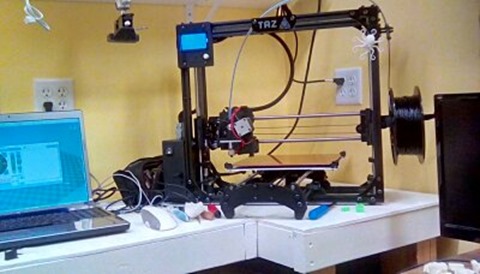 I had an interesting visit with family in St. Charles, Missouri over the weekend, but one of the more interesting things I saw this weekend was when I was back in Indianapolis, staying overnight with my brother Alex in Greenwood. He showed me the 3D printer he had set up in his workshop—a fascinating little machine that he used to create shapes and structures out of plastic.
I had an interesting visit with family in St. Charles, Missouri over the weekend, but one of the more interesting things I saw this weekend was when I was back in Indianapolis, staying overnight with my brother Alex in Greenwood. He showed me the 3D printer he had set up in his workshop—a fascinating little machine that he used to create shapes and structures out of plastic.
One of the especially interesting things about it was that you can actually print a number of the printer’s own parts on the device itself. Alex showed me a number of gears he’d printed that would be part of a new stock feeder for the printer, which would be attached to the frame instead of the head as it is now, so that the head could be lighter and move about more easily. He’s also looking into upgrading the printer so that instead of a single filament, it can print from three. This would allow it to use different materials and create internal structure more easily.
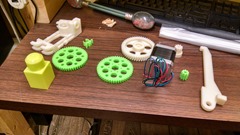
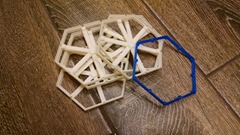 Those were far from the only things he could print, however. Alex showed me some hexagonal tile holders he had modified and printed for the board game Settlers of Catan, and a little folding TARDIS model he’d downloaded, too. Effectively, any three-dimensional object Alex could design, he could then print out. He even had a webcam trained on it so that he could monitor the output remotely from work.
Those were far from the only things he could print, however. Alex showed me some hexagonal tile holders he had modified and printed for the board game Settlers of Catan, and a little folding TARDIS model he’d downloaded, too. Effectively, any three-dimensional object Alex could design, he could then print out. He even had a webcam trained on it so that he could monitor the output remotely from work.
3D printers were a beneficiary of the recent DMCA exemptions, one of which would allow the bypassing of DRM to use unauthorized feedstock. However, the printer my brother owns doesn’t use proprietary feedstock, which is one of the reasons he chose that particular model.
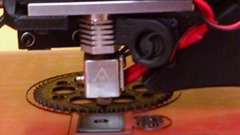
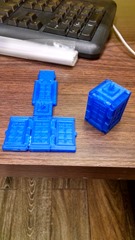 I discussed the possibility of printing a plastic replacement part for my Logitech keyboard—the flip-out props have a distressing tendency to crack and break off. Alex said he’d just need to take one and measure it, and design it in the CAD program he uses on his computer. 3D scanners do exist, but Alex doesn’t have one yet. “Though I might print one,” he said offhandedly, but completely seriously.
I discussed the possibility of printing a plastic replacement part for my Logitech keyboard—the flip-out props have a distressing tendency to crack and break off. Alex said he’d just need to take one and measure it, and design it in the CAD program he uses on his computer. 3D scanners do exist, but Alex doesn’t have one yet. “Though I might print one,” he said offhandedly, but completely seriously.
In these devices, I see some interesting parallels and applicability to e-books. Right now, 3D printers are specialty hardware, available in stores but expensive and complicated enough that you have to know a lot (or be willing and able to learn a lot) to use one, and you have to be willing to pay a lot of money to get them. People can own and use them, but by and large they’re the kind of advanced power-user my Electrical Engineering PhD. brother is. It’s kind of the same way e-book readers were in the days before the Kindle—they tended to cost more money than people wanted to spend, and were by and large too esoteric and unfriendly for the average reader to want to bother with.
But now I’m starting to wonder when we’ll see the “Kindle” of 3D printers—a device that’s cheap and easy enough for the average person to use that they just push a button and there it goes, and actually be able to do useful things with it. To an extent, anyway—ordinary users may never be able to wrap their minds around something as complicated as designing their own widgets. Still, if there are widgets that can be as easily-downloaded and printed as Amazon e-books can be downloaded to the Kindle, then that would still be a lot of extra utility for consumers—especially if there are plenty of power users around who could design new widgets by commission.
Furthermore, once these devices are ubiquitous, I could see an entirely new way of designing e-readers and tablets becoming possible. We already have miniature-computer kits like the Arduino, Raspberry Pi, and CHIP, that people can build into their own projects or install in specialty cases. What if it became more commonplace to offer the guts of an e-reader or tablet, like a name-brand Kindle or Galaxy Tab, by themselves, and provide design specifications for designing or customizing a case?
The internal-component kit would include the screen, board, and various external elements—buttons, camera, chip reader, battery terminals, etc.—connected by wires so they could be slotted into niches designed to fit them on the case. Then the cases could be designed with those niches in various places, and people who are good at the CAD programs could redesign them or create custom designs from scratch, to customize the case to fit different needs.
If someone is left-handed and wants the volume and power buttons on the left side instead of the right, it could be a simple change to make. If he wants to move the camera so it’s not right where he would put his fingers while he holds the case, then so be it. A suitably-talented designer could even take molds or measurements of the person’s hand and design the case specifically to fit their grip, like the little alien gizmo-redesigning critters did in The Mote in God’s Eye. There would no longer be any call to grumble about a manufacturer’s case being made wrong, or about the page-up and page-down buttons being in the wrong places—just buy a new case and use that instead.
I’m sure there will be a lot of other uses, though, that I can’t even imagine right now—just as I couldn’t have imagined ten years ago how current tablets and e-readers would look. It’s an exciting time, and I’m really looking forward to it.


































@Chris: Beautiful, thoughtful post. I love the idea of DIY e-readers. Some very good mass-produced e-readers might just come about, based on the creativity of the masses. See what Amazon is doing in providing script writing software? Maybe it could also encourage your DIY approach for e-readers and offer contracts for the most innovative designs. But baby steps first. Wouldn’t it be awesome if Amazon would even let us install our own fonts in Kindles without any fuss?
I designed a holder for my Kindle Paperwhite in its case to mount to an Ikea Tentenal lamp in place of the shade. I used my 3D printer to make it and a mount for the lamp to my headboard and can now read in bed more comfortably without my arms getting tired holding the Kindle up.
As to an e-reader or tablet kit, I think not. Heathkit showed that the cost of kitting and packaging is more than the cost of an assembled unit. It is why Heathkit is no longer making kits anymore. Modern mass production makes it impractical to do the kits competitively.